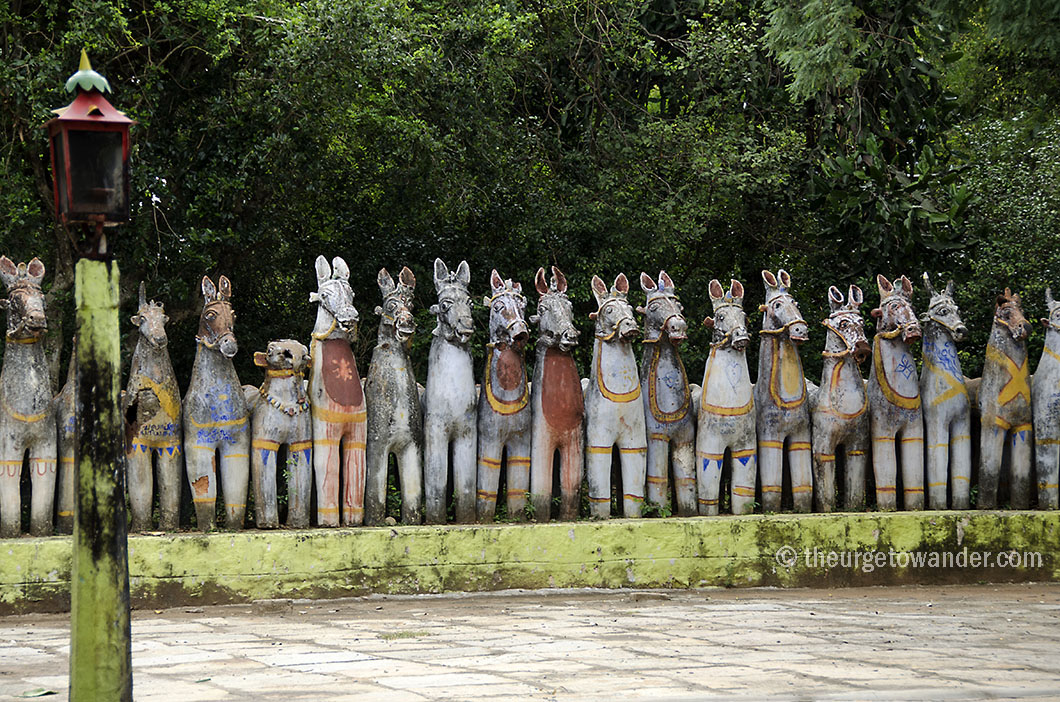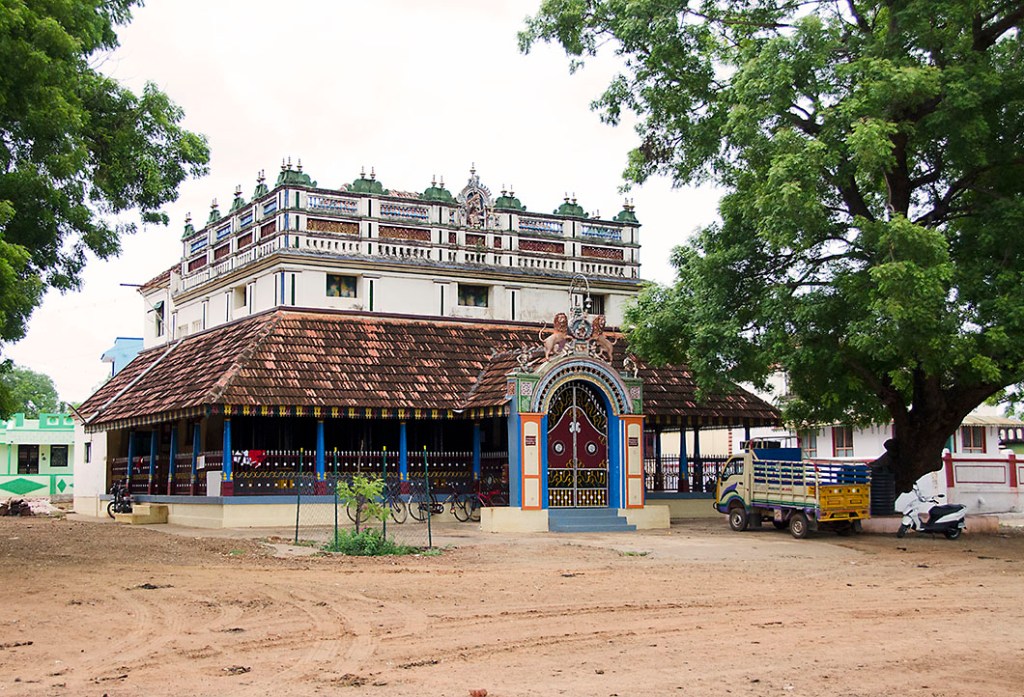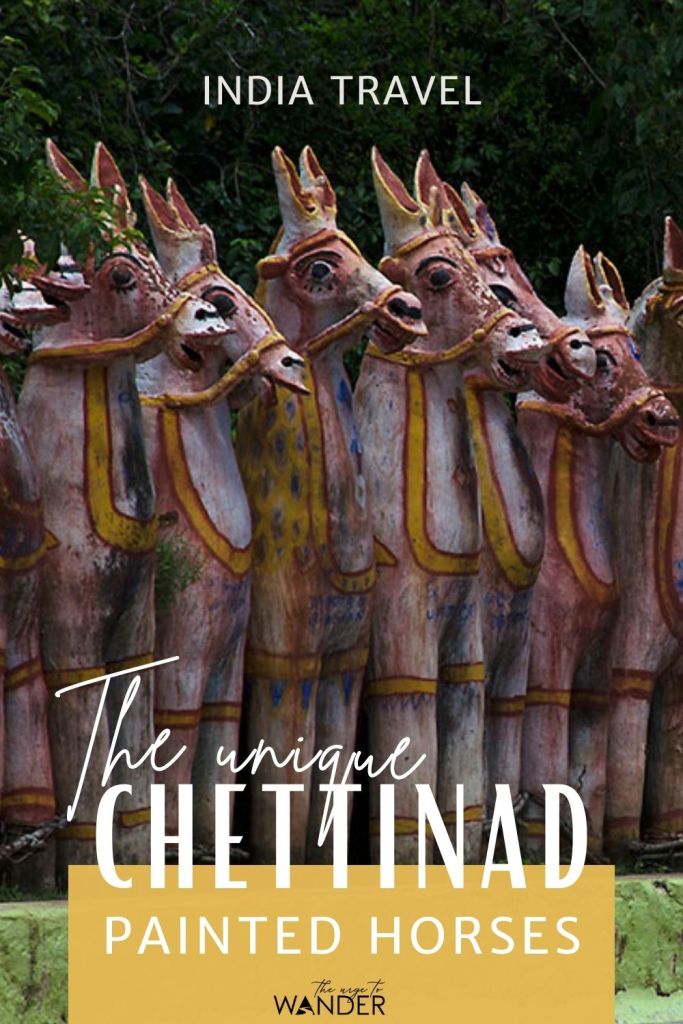The blue skinned equestrian ‘god’ sticking out of the pile of polished antiques was unlike any I had seen before. His swarthy complexion had me mistaking him for Krishna – our ‘playboy’ god – at first. The facial hair and the cobra around his neck, however, suggested he might be Shiva: The Destroyer.
But his mount was all wrong. Shiva is almost always depicted astride the Nandi, his white bull.
Intrigued, I decided to ask our friends but by the time we extricated each of them from the dank, dusty interiors of the Ali baba caves lining this Karaikudi street, it completely slipped my mind.

It was at the Solai Andavar temple in the Chettinad village of Palathur, the next morning, that I discovered he was Karuppusami – ‘the black deity’ – and chief associate of the village guardian Ayyanar. And neither belong to the populous Hindu pantheon!
Ayyanar is a pre Vedic Tamil deity, usually enshrined with 21 sub deities (including Karuppusami). His origins are shrouded in mystery and any historical facts buried in tradition.
He could very well have been a flesh and blood chieftain mythically transferred into the realm of the divine. It is generally believed that he evolved from the Dravidian Shakti cult with the advent of mainstream Hinduism from the North and the resultant shift from animist Goddess worship to the worship of male gods.
Over time the process of merging indigenous beliefs into organised Vedic religion transformed Ayyanar into ‘HariHaraPutra’: the son of Vishnu (Hari) in his female form as Mohini, and Shiva (Hara). This served to unite rival Shaivite and Vaishnav groups, while the (ex utero) nature of his alleged conception added legitimacy to his admission into the pantheon.
Although polygamous to begin with and depicted with his two consorts, he began to be identified with the more popular 11th century celibate deity Ayyappan with an extended scope of influence beyond the boundaries of the village.
I suspect that might be the reason pre-menopausal women – excluded from the puritanical Ayyappan cult – are banned entry into the sanctum in some Ayyanar temples like the Solai Andavar temple.

As the principal guardian deity, Ayyanar is charged – beyond the tasks of granting boons and ensuring bountiful rain and harvests – with the protection of the village from all calamities. And he is said to fiercely fulfil that duty by patrolling his fiefdom each night. Sword in hand. Astride his shining white stallion.
Traditional votive offerings in Ayyanar temples, therefore, are brightly painted terracotta horses. Commissioned by grateful devotees and crafted by attendant Velars (non Brahmin potter-priests) in sacred ceremonies that involve processions from the priests’ houses to clay pits in temple premises.
A mixture of (smooth and grainy) clay along with sand, straw and paddy husk is kneaded and shaped in specified order before being fired in resident kilns. They are then consecrated through rituals known as “Kutirai Etuppu’ (horse dedication) that are accompanied by trances and in some instances, animal sacrifice*.


That these beautiful clay steeds, arrayed along the periphery of remote shrines in Tamilnadu, continue to watch over the night time perambulations of their lord even after all these centuries, is a comforting sign of their resilience.
With younger generations moving to cities in the wake of globalisation, this hereditary pottery tradition of the Ayannar temples is as much under threat as the craft of the artisans of Kumartuli. A shift to moulded concrete horses has already begun.
*Animal sacrifice is banned by law.
HOW TO VISIT THE HORSE TEMPLE OF AYYANAR
DISCLOSURE: The Urge To Wander is part of the affiliate programs of some of the resources mentioned on these pages and will earn tiny commissions from qualifying purchases without any extra cost to you. Your support is appreciated. Disclosure policy.
GETTING TO CHETTINAD
Karaikudi is 90 km away by road from both Madurai and Trichy (Tiruchirapalli) the nearest airports. The Trichy road appears to be less crowded and makes for a slightly shorter journey. We realised too late that flights (from Chennai) to Trichy were cheaper as well. Driving from Bangalore or Chennai takes about 7 hrs. Alternately, overnight trains connect Chennai direct to Karaikudi.
GETTING TO THE SOLAI ANDAVAR HORSE TEMPLE
Private vehicles or taxis are easily organised by your accommodation once you get there. Set your GPS to (or request to be taken to) the Solai Andavar Temple. It Is known locally as Solai Andavar Ayyanar Koil.
Address: Kothari, Karaikudi Block, Palathur Post, Tamilnadu – India. See temple icon in map below. Have also marked the antique street, Muneeswaran Koil Street and The Bangla for reference.
PLEASE NOTE: This a private place of worship in a deeply conservative village. One is expected to dress modestly and respect local traditions. As mentioned above, pre-menopausal women (between the ages of 12-55) cannot enter the temple premises. It’s rather arbitrary depending on appearance so if you are a young looking grandmother who’s eligible, I suggest you carry your id.
Photography is permitted from the grounds.
MORE THINGS TO DO IN CHETTINAD:

- Karaikudi is widely known for its traditional Chettinad houses and mansion hopping around the Chettiar clan villages is THE thing to do.
- Join a traditional cookery class. See below.
- Explore the craft revival projects of Chettinad.
- Kandanghi handloom saris received the geographical Indications (GI) tag in the year 2013. Get your hotel to organise a visit to a weaving centre.
- Visit the traditional tile making unit and palace in Athangudi (15 km north, 25min by road.
- Palmyra basket weaving is another indigenous craft that are worth checking out.
- There might not be true antiques left in the ‘Antique Street’ of Karaikudi, but it’s dusty shops are a treasure trove of interesting artefacts. I particularly love the enamelled cooking pots to use as planters/vases. And I lucked upon a pair of traditional painted Marapachi wooden dolls.
BEST TIME TO VISIT CHETTINAD
Karaikudi is an all year destination if you can handle the heat. The monsoon season from October to November is more pleasant with likelihood of moderate rain. Best time to visit is during the relatively drier and cooler period between mid December to March.
CHETTINAD TRAVEL RESOURCES
Contact the Bangala for the best cookery classes in the region.
Find best rates for the heritage accommodation mentioned above or for others within your budget In Karaikudi & Kanadukattan.
OTHER PLACES TO VISIT BEYOND CHETTINAD
- THANJAVUR (About 90 kms north, 2 hours by road.)
- MADURAI (About 90 kms west, 2 hours by road.)
- TIRUCHIRAPALLI (About 90 kms north, 2 hours by road.)
- RAMESWARAM (About 130 kms south, 3 hours by road.)
- AVUDAIYAR KOIL (40 km east of Karaikudi.)
SOUTH INDIA ON YOUR RADAR? 📌 PIN FOR LATER



HOW COME I WAITED TO GET TO 90 years, TO READ AND LEARN ABOUT MY OWN ANCESTORS. MY LOSS, STILL I OWE LOTS OF 🙏🙏🙏🙏 to you and your research. ADMIRABLE.
Thank you Sachidanandan 🙏
that is wonderful 🙂
Great Pics!
I welcome you to my Blog.
Shiva
Lovely post. These horses look super cute.
Wow, I didn’t know that Aiyyanar was a pre-Vedic deity.
Destination Infinity
Nice to read, Beautiful photos
Nice photographs.
Super interesting Madhu!!! Love it!!!
how interesting…to discover new (er…old) gods!! And with blue skin… and, “playboy god” yeah, love that!! thanks for the insight!!
Madhu what beautiful creatures they are, I hope concrete ones don’t take over. If that happened African giraffes. I want to see these objects in situ not in some shop when they have been mass produced and unfairly traded. A great post and really good to learn of a different deity!
As always you provide stunning visual images along with the history. Fascinating this time as you give the timeline of transition and adoption.
Intriguing read.
What a wonderful idea these horses – do beautifully done and your pictures are excellent!!! 🙂
errr …so! [not ‘do’]
I’ve always wondered about the significance of those horses in South India. Thanks for the interesting history.
What do you mean by joint-family?
This post is perfect for bringing out the importance and immense feeling of history and culture. I would have guess Krishna right away, but then when you mention Karuppusami, I realize how poor my knowledge of the Hindu religion is 🙂 The history and flow of your words are fantastic – go well with your photos. Beautiful post Madhu.
The horses are absolutely beautiful! I have to say that reading and trying to keep all those Hindu god and place names straight was like reading a Russian novel – I needed a chart to help me out! Fascinating story, though, and worth the concentration on my part!
I saw some of these horses in Tamil Nadu! I think it was when we walked around the inner path of Mt Arunachala (which is now closed). We all wondered about them. Now I have the answer. All these ones are quite beautiful.
Alison
Stunning images and found the history very interesting. Thanks for sharing.
OMG! I adore these horses, Madhu! I want them lining my own home, watching over our gods’ nighttime activities here! So sad this marvel may be ending, but maybe people will save it? I loved hearing the stories here, too. Thank you! 🙂
Thank you for your description. 🙂